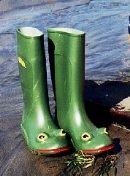I've been painting my bathroom, a task that SHOULD have been a snap but turned into an ordeal. If I knew how to drywall, OR knew someone who would put up drywall for me for cheap, I could have solved a lot of my problems.
However: that is not to be.
My house is 100 years old this year. The property info I have lists it as being built in 1910 - thus, the centennial celebration of my little old house.
My dad recently came across some historical information about drywall and its precursors (don't even ask. we're a family of nerds). And, after doing a bit more research, he informs me that what I have in my house is almost certainly a pre-drywall called Sackettboard, which became gypsum board, then became drywall.
Sackett board is an alternative to the lathe-and-plaster mode of wall construction, which was costly and time-consuming. It's made of layers of plaster and a kind of felty cardboard, and is installed much like drywall. It has unfinished edges and is quite, quite heavy, which made it hard to work with (thus the refinements of gypsum board and drywall).
Sackettboard was only around and in use for maybe 10-15 years, before the other, better kinds of boards were devised. My house falls smack in the tail end of that period, but almost certainly before gypsum board made its appearance. And my walls - the ones I've exposed, anyway - are a weird kind of felty cardboard . With plastery stuff underneath. Sackettboard didn't take paint or wallpaper very well, evidently, but the fellow who built my house (referred to in the property listing simply as Dad, and called Dad by me and my family) slapped up wallpaper, and then - when things needed refreshing - he just painted over the paper.
Which meant that, to repaint the bathroom, I had to peel off the paper (the paint was chipping, the paper was bubbling). Down to the felty cardboard.
So my walls are lumpy and bumpy and funny looking.
Part of me wishes I had the financial wherewithal to have nice, new, smooth drywall installed. The room would be polished and tidy and clean - all white, with a black-and-white floor, with a nice vintage feel. But another part of me thinks it's amazing - amazing! - that the walls in my bathroom are the originals from 100 years ago. The chips and scores and bumps are the history of the walls, the history of the house. Same with the wood trim around the doors and windows - there are bumps and bruises where Dad clearly missed the head of the nail and just knocked a circle into the wood.
There's a weird, scratched-together feel about my house, which sometimes makes me feel awkward. But I love the quirkiness of it, and the age. I live in a house from 1910 - 1910!!!!! with original walls and woodwork. chipped and scarred, yes, but one hundred years old and still standing and quite, quite functional.
I LIKE old cracked and chipped peeling paint. I LIKE outmoded countertops and tiling and no granite anything, anywhere. I like the weird faux-wood graining on the wood trim. I like how my house sometimes feels like the cabin of a ship, and sometimes feels like the weirdest little dollhouse cottage in the world. Sometimes, in summer, it feels like a treehouse.
so my bumpy, funny-looking walls don't bother me that much. They need another coat of paint, probably, to be finished, but they'll still show their age.
And for a 100-year-old house, I'd say this one's doing all right.
15 February 2010
Subscribe to:
Post Comments (Atom)

No comments:
Post a Comment